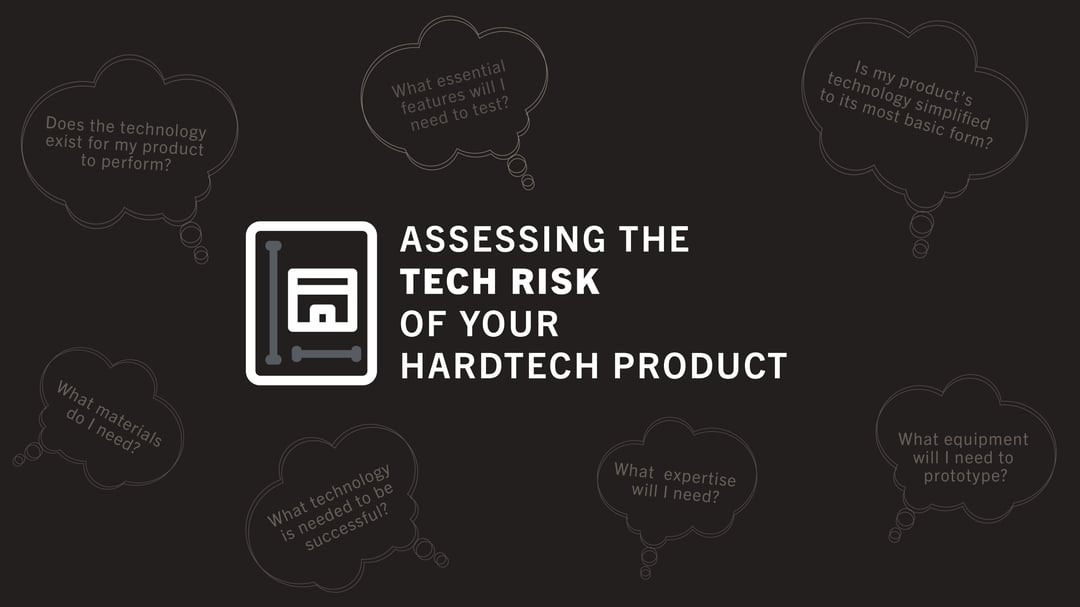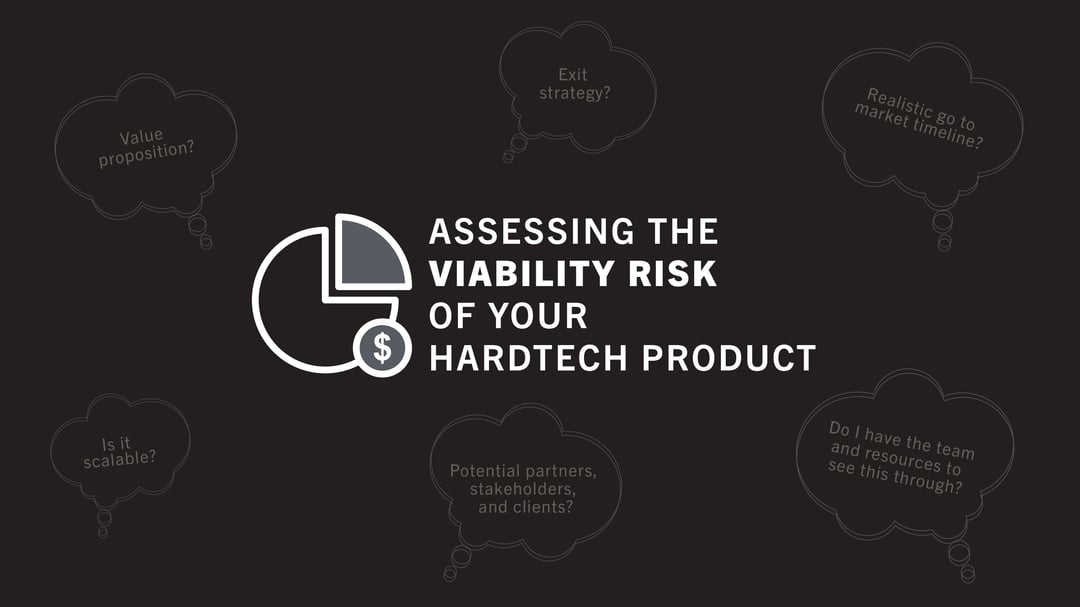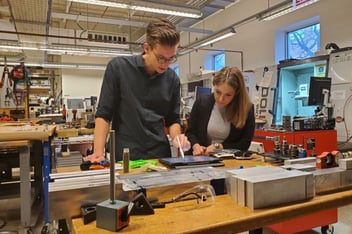If you asked a room full of startup founders how they got their products to market, you would get vastly different responses. This is especially true of hardtech startups, where the innerworkings of hardware innovation, market requirements, and production processes are even more nuanced and capital intensive.
The reality is that there is no secret product development formula. The path to commercialization isn’t linear. You should anticipate winding roads with a roadblock at every turn. It doesn't matter how innovative and disruptive your product idea is, you can’t navigate the path if you’re blinded by the lightbulb going off above your head. You can, however, use it to light the way.
Before embarking on a product development journey, evaluate the risks associated with getting your product to market. At the very least, you'll have identified some of the biggest roadblocks ahead and have a sense of how to steer clear of them.
Three Areas of Risk Management to Consider as an Early-Stage Startup
Perhaps the most constant roadblock for startup founders is managing the risks that come from developing a hardtech product. The bleeding edge of technological innovation is a slippery one, no matter if you’re a first-time innovator, a hobbyist inventor, or an experienced entrepreneur. Let’s look at each of the three major risk areas you’ll encounter.
Area One: Tech Risk

Many startup founders have backgrounds in engineering or work in the industry they are developing their product for. It’s no surprise that they’d be eager to start vetting the technology and prototyping, but there are a number of things to do before spending any time, money, or resources on the physical tech. The way to scratch that itch early-on is thinking conceptually about your product and evaluating the potential tech risk involved.
Tech risk stems from any technology your product requires to function with a potential to A) be difficult to source and manufacture, or B) not work. Point A can refer to any components of the product’s design that are too costly or difficult to obtain due to supply chain issues, resource scarcity, etc. Point B would be any technology that is too complicated or advanced for your use case. Think flying cars or dream recording machines— the line between innovative and impractical is often paper-thin.
A Product Requirements Document (PRD) answers all the questions above by breaking your product down to its nuts and bolts. A PRD can also be a baseline for you to reference and evolve at any stage. Given how quickly technology advances and markets change, you need to constantly check the functionality and user requirements needed in your final product, and what tech risk may be involved.
PRD templates and examples can be found all over the internet, but it's meant to be a fluid and customizable document for any founder. Fill out a PRD as an exercise to step back and define the needs and expectations of your product’s technology. It will highlight where there may be gaps in knowledge or skillsets, and it can predict where additional research, testing, and support may be needed. In an industry where rapid prototyping is a necessity, save yourself time and resources by approaching prototyping with a clear vision. Whatever preconceived notions you have about your product’s technology could go right out the window when you sit down and map out how it works and how users will interact with it.
To learn more about the rapid prototyping phase, read: Rapid Prototyping: What to Expect during an Iterative Product Development Process.
Another feature you’ll often find in a PRD is a Competitor Analysis. Looking at your competitor’s technology is particularly helpful early on. You don’t want to reinvent the wheel, but you also don’t want to develop technology so niche and innovative there’s no market for it yet. Both sides of this spectrum have their unique challenges and benefits, and you can identify where to balance your product between them by seeing where competitors do.
What you learn from a Competitor Analysis will also bleed into how you mitigate the other risks outlined in this article. Remember that the product development process isn’t linear, so steps like risk evaluation aren’t a one-and-done deal, but something you’ll constantly circle back to.
Area Two: Market Risk

Think about market risk as a potential lack of demand for your product. It’s only possible to generate revenue if you’ve identified a problem, a real solution for it (your product), a market, and a base of customers who will both want to buy it and can afford to.
At the genesis of your hardtech product idea, a Marketplace Requirements Document (MRD) can identify the problem that needs solving, validate that your product is a solution, and discover if there is a market out there for it.
Just like a PRD, an MRD is an exercise or tool to evaluate your product’s current market risk. It will help you identify where there’s work left to be done, and each update and revision you make is a roadblock you’re moving before you’ve stepped onto the path. When you begin moving towards commercialization, your MRD will become an evolving roadmap to reference at future points in the product development process.
In the earliest stages of your product development journey, you should spend most of your time conducting research on your market. Once you’ve identified a market and customers, evaluating the market risk is an opportunity to think about the narrative of your startup and how you will eventually pitch to investors.
The need for funding will sneak up on you faster than you expect, so it’s beneficial to keep information about your product market in your back pocket. If your market is niche, you should find realistic data or customer testimonials that support your product’s market potential, rather than inflating its current market fit. For B2B startups, it’s also important to note that evaluating market risk is not just to validate who will be using your product, but more importantly, who will be paying for it.
To learn more about understanding and testing your market, read: Market Testing and Validation for Physical HardTech Products
Area Three: Viability Risk

Once you’ve started thinking through your hardtech product’s technology and market fit, it’s time to evaluate the viability risk. Or rather, whether the path is clear enough to predict if your product can get to market, generate revenue, and support long-term growth.
At this point, you’ll probably have spent a good amount of time researching and outlining your product development process, but little to no money and resources. If it becomes clear at any point that your product is not viable, then no real harm has been done. The same may not be said if you don’t take the necessary steps to evaluate risks ahead of time and dive into the more costly stages of product development.
Another tool that is great for strategically outlining your product development pathway is Alexander Osterwalder’s Business Model Canvas (BMC).
Let’s say you’ve nailed down your product’s technology and market fit—the product’s technology is sound, and you’ve got plenty of data to support your target market and customer. Try outlining your business objectives in the BMC to answer how you’re going to get your final product in your customers’ hands. There’s bound to be some gaps here, and you would be doing yourself a favor by figuring out how to fill them sooner rather than later.
 Download mHUB’s Business Model Canvas (BMC) Template
Download mHUB’s Business Model Canvas (BMC) Template
Some innovators think they can avoid the headache by pitching their idea to an investor before they’ve gone to market, as though the investor will want to purchase the IP and figure out how to manufacture it themselves. This is not a reliable shortcut, and 99% of the time you’ll have more luck pitching to investors after you’ve manufactured the product and have some sales data to show for it. There are avenues to acquisition, but that sort of exit typically happens after you’ve gotten your product to market.
Where Do You Go Next?
During your hardtech product development journey, you will inevitably have to take some risks. After all, becoming an entrepreneur, let alone a hardtech startup founder, is a risk all on its own. Still, you can get in the habit of identifying and managing your product’s tech, market, and viability risks early on and save yourself some trouble down the road.
Some roadblocks won’t be so easily moved, and you shouldn’t be deterred when the risks you do take don’t pan out. Starting a business and developing a hardtech startup isn’t easy. All those gaps in skill, knowledge, and resources you identified with the PRD, MRD, and BMC will need to be addressed, but there are tons of resources out there for product developers and startup founders.
If you don’t already have the tools and resources to start prototyping, look into programs and centers in your area that can help you. If you're a college student, your university might have an innovation lab or programs for entrepreneurs. Your city might have makerspaces or workshops with equipment that can be rented. Large cities often have innovation centers that offer similar resources as universities, but that can be accessed by anyone for a membership fee.
Navigating your Product Development Journey
In the Great Lakes region, the Chicago Small Business Center (SBC) helps businesses with licensing, public way use permitting, and other resources to start and grow a business. In Chicago, mHUB has 11 prototyping labs for product engineering, but also offers members classes and access to mentors, contractors, and investors. The mHUB Accelerator program incubates high-potential, early-stage startups developing demand-driven HardTech solutions for challenges in Sustainable Manufacturing, Industrial IoT, MedTech, and Energy Tech.
Based in or around Chicago? Check out mHUB's membership options, book a tour, or register for one of many mHUB classes on product development.






